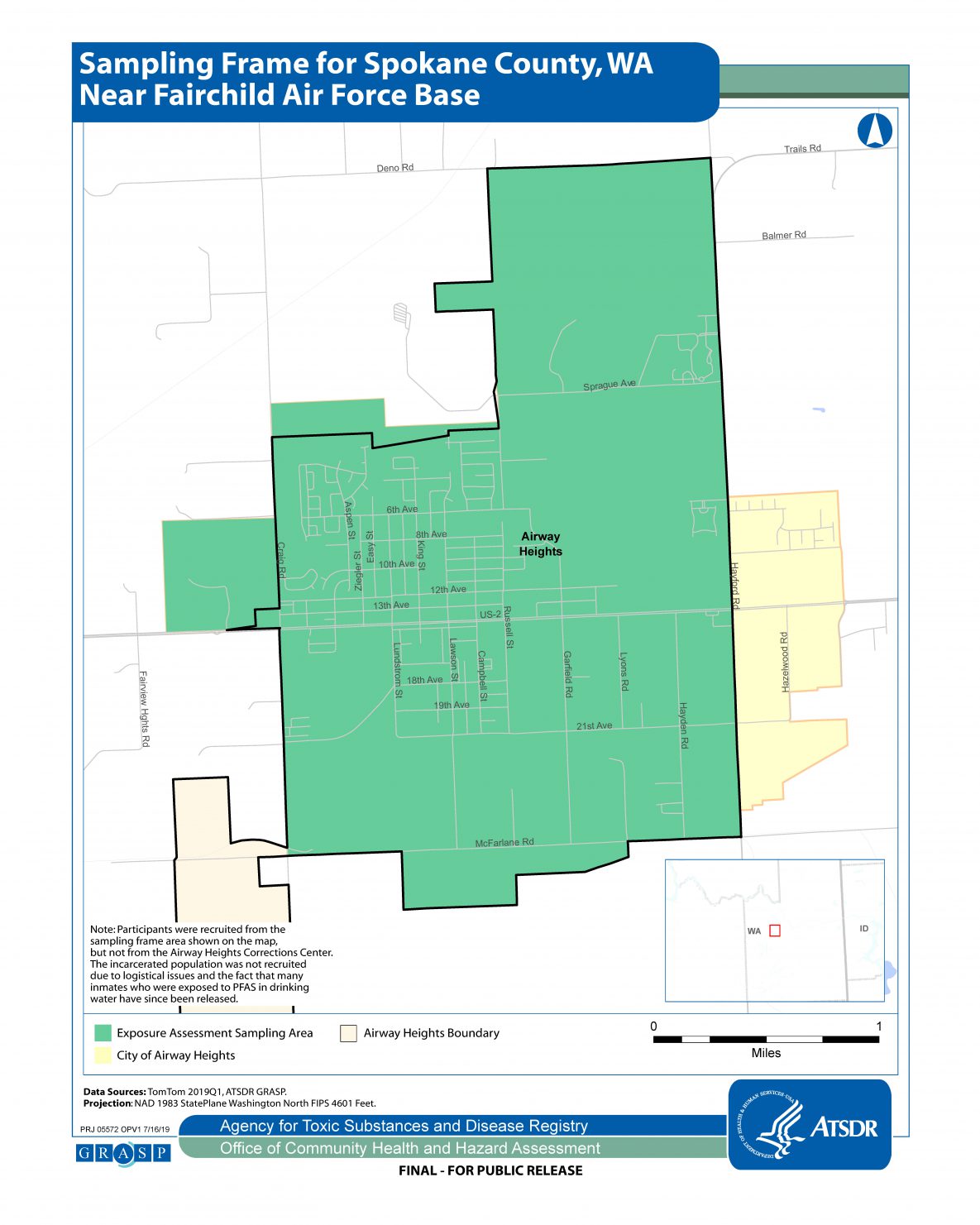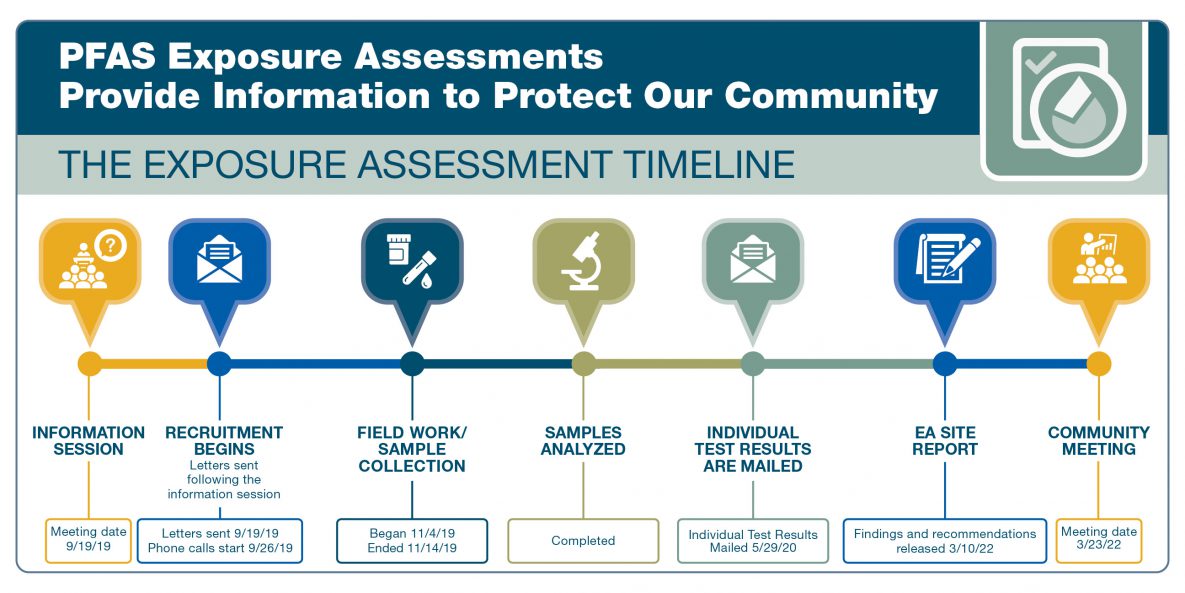Spokane County (WA) near Fairchild Air Force Base

Background
In 2019, the Centers for Disease Control and Prevention (CDC) and the Agency for Toxic Substances and Disease Registry (ATSDR) conducted an exposure assessment (EA) from the City of Airway Heights, Spokane County, Washington, near Fairchild Air Force Base. CDC/ATSDR sent the individual test results to participants and released summary results to the community in May 2020. The PFAS exposure assessment report [PDF – 2 MB] was released in March 2022.
Why did we select the Airway Heights?
When selecting EA sites, ATSDR considered the extent of PFOA and PFOS contamination in drinking water supplies, the duration over which exposure may have occurred, and the number of potentially affected residents. Airway Heights was one of several sites nationwide identified with PFAS drinking water contamination from use of products such as aqueous film forming foam (AFFF).
As early as the 1970’s, the Base used AFFF containing PFAS for firefighter training. Over time, the PFAS from the AFFF entered the ground, moved into the groundwater to offsite locations, and affected nearby municipal wells. PFAS were first detected in Airway Heights municipal wells in May 2017. Airway Heights authorities immediately removed the contaminated drinking water wells from service and provided residents bottled water until drinking water could be obtained from the uncontaminated City of Spokane water supply. By June 2017, the city declared the water safe to drink. Since 2017, Airway Heights has reactivated some of its drinking water wells with treatment systems to remove PFAS.
Based on the information ATSDR has reviewed, the City of Airway Heights public drinking water supply currently meets or is below the U.S. Environmental Protection Agency’s (EPA) 2016 health advisory (HA) for PFAS in drinking water. At this time, ATSDR does not recommend community members who get drinking water from the City of Airway Heights’ public water supply use alternative sources of water.
How was testing conducted?
ATSDR invited Airway Heights residents who met eligibility criteria to participate in the EA. Household members were eligible if they had
- received drinking water from the City of Airway Heights Water Department and lived west of Hayford Road for at least 1 year before June 8, 2017 (these residents have the greatest likelihood of past exposures to PFAS via the public drinking water supplies)
- been greater than three years old at the time of sample collection, and
- not been anemic or had a bleeding disorder that would prevent giving a blood sample.
Households with private wells were not eligible for participation. Measuring PFAS in the blood of people from selected households allows us to estimate exposure from consumption of public drinking water for the entire community in the affected area, even those who were not tested.
Results
In May 2022, CDC/ATSDR released a summary of the biological and environmental test results. The full report was released March 10, 2022 and a summary of the report’s findings is presented below. The full report is available here [PDF – 2 MB].
ATSDR
analyzed data from
333
people
(286 adults and 47 children)
from
168
households
Everyone completed a questionnaire
and most people provided
blood and urine samples.
ATSDR collected samples of tap
water and dust from some homes.
ATSDR sent each participant their individual results in May 2020 and published community summary results at
www.atsdr.cdc.gov/pfas/communities/factsheet/Spokane-County-Community-Level-Results-Factsheet.html.
Key Takeaways
- Levels of some PFAS in the blood of Airway Heights residents were up to fifty-six times higher than national levels.
- Elevated blood levels may be linked with past drinking water contamination.
- Some demographic and lifestyle characteristics were linked with higher PFAS blood levels.
- All tap water samples collected during the EA in 2019 met or were below EPA’s health advisory and Washington state public health guidelines for PFAS in drinking water.
The average blood levels of five PFAS (PFHxS, PFOS, PFOA, PFNA, and PFDA) in Airway Heights EA participants were higher than average levels nationwide.
Of the seven PFAS tested at the New Castle County EA site, at least one PFAS was detected in all participants. And all 7 PFAS were detected in more than 60% of the blood samples collected: PFHxS, PFOS, PFOA, PFNA, PFDA, PFUnA, and MeFOSAA.
Since 1999, the National Health and Nutrition Examination Survey (NHANES) has measured PFAS levels in blood in the U.S. population, and PFAS levels are shown to be age dependent. In its analysis, ATSDR adjusted blood levels of EA participants at the New Castle County EA site for age to enable meaningful comparison to the NHANES dataset. After adjusting for the effects of age, PFHxS, PFOA, PFOS, PFNA and PFDA were all elevated compared to levels nationwide. Age-adjusted averages are more representative the New Castle County EA site community.County EA site community.
Elevated blood levels of three PFAS in the Airway Heights EA participants may be linked with past contamination of the city’s drinking water.
Three PFAS (PFHxS, PFOS, and PFOA) were detected in Airway Heights’ drinking water in 2017. We do not know if contamination began earlier, because no data are available before 2017. By 2017, Airway Heights municipal drinking water met the EPA’s HA for PFOA and PFOS. There were over 2 years and 5 months between the reduction of exposure via contaminated drinking water and the collection of the EA blood samples. Because of the long half-lives of PFHxS, PFOS, and PFOA in the human body, past drinking water exposures may have contributed to the EA participants’ blood levels. Typically, participants who had elevated blood PFHxS levels also had elevated blood PFOS and blood PFOA levels. This suggests a common source of exposure, such as the Airway Heights public water supply (prior to June 8, 2017). Other sources of exposure were not measured but could have contributed to PFAS concentrations measured in blood of the EA participants.
Long-time residents had higher PFHxS, PFOS, and PFOA blood levels.
For every additional year an adult participant lived in Airway Heights, there was an increase in blood PFHxS (7.2%), PFOS (5.6%), and PFOA (3.9%) levels.
Blood levels of PFHxS, PFOS,
and PFOA were higher in older
participants. These PFAS increased by 1.1% to 1.8% for every year of participant age.
Males had 77% higher PFNA
blood levels than females.
Participants who ate fast food a few times per month had lower blood PFHxS, PFOS, PFOA, PFNA, and PFDA blood levels compared to participants who ate fast food a few times per year or less. This finding differs from other studies and may be due to differences in diet and lifestyle correlated with fast food consumption.
Adult participants who identified as non-White or Hispanic had higher PFNA and PFDA blood levels than White, non-Hispanic participants:
PFNA 37% higher | PFDA 33% higher
Female participants’ PFAS blood levels decreased with increasing number of child births.
For each child, PFAS levels were
PFHxS 11.7% lower | PFOS 9.3% lower
PFOA 13.7% lower | PFNA 8.1% lower
Participants who reported ever
Using stain-resistant products had 26% higher blood levels of PFDA than participants who reported never using these products.
Adults who reported a
donating blood at least once a year had lower blood levels of PFHxS (67%), PFOA (60%), and PFNA (49%) than participants who never reported donating blood.
Fact sheets and Report
- PFAS Exposure Assessment, Spokane County, WA: Report [PDF – 2 MB] (3/10/2022)
- PFAS Exposure Assessment, Spokane County, WA: Report Appendix [PDF – 3 MB] (3/10/2022)
- PFAS Exposure Assessment, Spokane County, WA: Report Consumer Summary [PDF – 364 KB] (3/10/2022)
- PFAS Exposure Assessment, Spokane County, WA: Fact Sheet [PDF – 268 KB]
- PFAS Exposure Assessment, Spokane County, WA: Community-Level Summary Results Fact Sheet [PDF – 94 KB]
CDC and ATSDR invite all residents of the City of Airway Heights to attend a virtual information session to learn more about the results of the PFAS exposure assessment. Experts will also answer community questions.
When
March 23, 2022
Time
6:00 p.m. PT
To register, go to: https://bit.ly/SpokaneEAMtg
ATSDR staff will additionally host small online meetings to answer questions. Sign up here: https://bit.ly/SpokaneEASmallMtg


